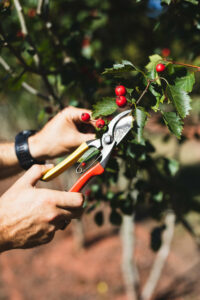Pruning is about creating the ultimate unique shape of the tree. It is a highly skilled art which demands a degree of competence, that takes some time to achieve. The techniques are important because once a tree is badly pruned it will never recover. Good pruning techniques, on the other hand, can create something really pleasing and natural looking, to the extent that most people would not be aware, that a tree had been pruned at all.
Well pruned multi-stem trees are good for garden designers because they have a small footprint with a large canopy, allowing designers to benefit from the large canopy, whilst retaining the small footprint beneath to give space for planting. The end result is aesthetically pleasing and can create an instant impact in the garden.
For further information about particular tree types and their best time of year for pruning, you can find a wealth of information at The Aboricultural Association

Multistem trees grow like any other tree and in order to keep them to a desirable size, they have to be pruned. This will ensure a beautifully shaped canopy to be enjoyed for a long time.
Crown lifting involves raising the height where the canopy begins from the ground. This procedure can be performed at any time of the year. It entails the removal of smaller branches and twigs, while retaining the thicker stems that form the multistem. You will need to continue removing branches until the desired height is reached, without over-thinning the canopy, which could result in an unnatural, almost comical appearance. For instance, trees like Acer campestre (Field Maple) can be lifted high enough for people to stand under. While others like Amelanchier x lamarckii (June Berry) may only need to allow for underplanting.
Multistem tree canopies can be maintained at the desired size by carefully pruning at the right times of the year. An initial pruning can take place after the first spring growth flush, typically around the beginning of June. This allows the second growth flush to thicken the canopy without adding much height, since the second flush generally grows slower. On certain tree varieties, such as Carpinus betulus (Hornbeam), you may need to perform another cut during the winter months. We recommend using shears for canopy trimming to create a more naturalistic effect, as opposed to mechanical hedge trimmers, which result in a uniform rounded shape, unless that is your desired outcome.
Crossing branches are more easily identified during the winter months, making it the ideal time to remove them. These branches can create open wounds, allowing harmful pathogens to enter the tree and harm it. You can evaluate both branches and decide which one to remove without significantly altering the overall canopy shape. The one that causes the least disruption to the canopy’s form should be removed. Some trees, like Crataegus monogyna (Hawthorn), have dense canopies, and the touching branches don’t rub against each other, so they can be left untouched.
Certain trees, such as Amelanchier x lamarckii (June Berry), produce suckers that emerge from the base of the tree and need to be removed. These suckers typically grow rapidly and straight. If left unchecked, they can alter the tree’s shape and overall appearance.
For more information on winter pruning check out our recent blog article
Follow us on instagram
The Barn, Broadley Lane, Stoke Gabriel, Totnes, Devon, TQ9 6RR





To provide the best experiences, we use cookies to store and/or access device information. Consenting to these technologies will allow us to process data such as browsing behaviour or unique IDs on this site.